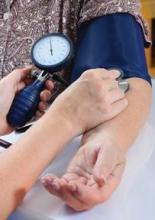A group of professional societies has issued the first set of quality improvement measures that focus on primary and secondary prevention of coronary artery disease and hypertension in the ambulatory setting.
The 10 measures were characterized as groundbreaking by the committee that wrote the guidelines, not only because they are the first to focus on outpatient care, but because they also go beyond just treatment recommendations to asking health care providers to control target goals. Patients are also urged to play a big role in improving the quality of their own care. According to the measures, patients are expected to keep appointments, modify their lifestyle, and adhere to medication regimens.
"It is our hope that application of these performance measures will provide a mechanism through which the quality of medical care can be measured and improved," wrote the authors.
The 2011 Performance Measures for Adults With Coronary Artery Disease and Hypertension were compiled by a writing committee that was led by the American College of Cardiology Foundation (ACCF), the American Medical Association, and the American Heart Association. They were published in Journal of the American College of Cardiology (JACC 2011 June 13 [doi:10.1016/j.jacc.2011.05.002]).
The last such measures were issued in 2005.
Seven of the performance measures were carried over, but they were updated. For instance, in 2005, practitioners were asked to measure blood pressure in patients with coronary artery disease. The new measure requires blood pressure control, and gives the parameters for that control. Similarly, for lipids, the guideline has evolved from measuring and providing medications, to also reporting on control of the condition. In the past, symptoms and activity were evaluated separately, sometimes giving a false view of angina. Practitioners are now asked to assess the two simultaneously.
The measures also still urge tobacco use screening, and cessation and intervention, and contain guidelines on prescribing and monitoring beta-blocker, antiplatelet, and ACE inhibitor therapy. For hypertension, the new guidelines combined two measures on blood pressure measurement, and coming up with a plan of care, into one measure that tracks the control of blood pressure.
There are two new measures. The first puts an emphasis on symptom management. It requires physicians to track the percentage of patients 18 or older with a diagnosis of coronary artery disease seen within a 12-month period, reporting on activity evaluation – evaluation of the presence or absence of anginal symptoms with appropriate management of those symptoms. If there are symptoms, physicians should document a plan of care to control them.
A second measure calls on physicians to refer all patients who’ve had an acute myocardial infarction, coronary artery bypass graft surgery, percutaneous coronary intervention, cardiac valve surgery, or cardiac transplantation, or who have chronic stable angina to a rehabilitation or secondary prevention program. The committee found that rehabilitation programs are severely underused and aims to use the measure to highlight the gap in care.
A measure requiring screening for diabetes in coronary artery disease patients was retired. It was considered "difficult to implement," according to the authors, and thus was not widely used.
Although compliance with medication therapy is crucial, the committee decided against adding a measure on medication adherence. It was debated, but the main objection was that "although prescribing physicians have some influence on patient choices, adherence is largely not in the individual physician’s locus of control." The committee envisioned that if such a measure existed, physicians might avoid caring for patients who were nonadherent.
It decided that adherence measures in guidelines in HEDIS (Healthcare Effectiveness Data and Information Set) would probably be more helpful, as those are used by insurers and employers to wield influence over patients.
The panel considered and rejected several other measures, including one that would have looked at overuse of stress testing, and others on appropriate use of percutaneous coronary intervention.
All of the measures were written to complement existing National Quality Forum–endorsed measures in coronary artery disease and hypertension, said the authors.
The committee also decided to go ahead with its recommendations, even though several other major guidelines are in the process of being written, said the authors. Those include the Eighth Report of the Joint National Committee on Prevention, Detection, Evaluation, and Treatment of High Blood Pressure (JNC-8); an ACCF/AHA guideline on stable ischemic heart disease, and the Cholesterol Education Project’s Adult Treatment Panel IV.
The writing committee also included representatives from the American Academy of Clinical Endocrinologists, the American Association of Cardiovascular and Pulmonary Rehabilitation, the American Academy of Family Physicians, the American College of Emergency Physicians, the American College of Radiology, the American Geriatrics Society, the American Nurses Association, the American Society of Health-System Pharmacists, the Society of Hospital Medicine, and the Society for Thoracic Surgeons.

